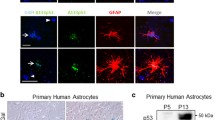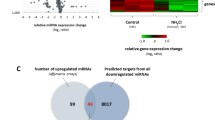Abstract
Astrocytes are the main homeostatic cells in the central nervous system (CNS) that provide mechanical, metabolic, and trophic support to neurons. Disruption of their physiological role or acquisition of senescence-associated phenotype can contribute to the CNS dysfunction and pathology. However, molecular mechanisms underlying the complex physiology of astrocytes are explored insufficiently. Recent studies have shown that miRNAs are involved in the regulation of astrocyte function through different mechanisms. Although miR-21 has been reported as an astrocytic miRNA with an important role in astrogliosis, no link between this miRNA and cellular senescence of astrocytes has been identified. To address the role of miR-21 in astrocytes, with special focus on cellular senescence, we used NT2/A (astrocytes derived from NT2/D1 cells). Downregulation of miR-21 expression in both immature and mature NT2/A by the antisense technology induced the arrest of cell growth and premature cellular senescence, as indicated by senescence hallmarks such as increased expression of cell cycle inhibitors p21 and p53 and augmented senescence-associated β-galactosidase activity. Additionally, in silico analysis predicted many of the genes, previously shown to be upregulated in astrocytes with the irradiation-induced senescence, as miR-21 targets. Taken together, our results point to miR-21 as a potential regulator of astrocyte senescence. To the best of our knowledge, these are the first data showing the link between miR-21 and cellular senescence of astrocytes. Since senescent astrocytes are associated with different CNS pathologies, development of novel therapeutic strategies based on miRNA manipulation could prevent senescence and may improve the physiological outcome.






Similar content being viewed by others
Abbreviations
- anti-miR-21:
-
antisense-miR-21 transduction construct
- miR-21:
-
microRNA-21
- NT2/A:
-
astrocytes derived from NT2/D1-cells
- RA:
-
retinoic acid
- SA-β-gal:
-
senescence-associated beta-galactosidase
- SCI:
-
spinal cord injury
References
Rajman, M., and Schratt, G. (2017) MicroRNAs in neural development: from master regulators to fine-tuners, Development, 144, 2310-2322.
Qureshi, I. A., and Mehler, M. F. (2012) Emerging roles of non-coding RNAs in brain evolution, development, plasticity and disease, Nat. Rev. Neurosci., 13, 528-541.
Anastasov, N., Hofig, I., Vasconcellos, I. G., Rappl, K., Braselmann, H., et al. (2012) Radiation resistance due to high expression of miR-21 and G2/M checkpoint arrest in breast cancer cells, Radiat. Oncol., 7, 206.
Chan, J. A., Krichevsky, A. M., and Kosik, K. S. (2005) MicroRNA-21 is an antiapoptotic factor in human glioblastoma cells, Cancer Res., 65, 6029-6033.
Zhang, W. M., Zhang, Z. R., Yang, X. T., Zhang, Y. G., and Gao, Y. S. (2018) Overexpression of miR21 promotes neural stem cell proliferation and neural differentiation via the Wnt/betacatenin signaling pathway in vitro, Mol. Med. Rep., 17, 330-335.
Liu, R., Wang, W., Wang, S., Xie, W., Li, H., and Ning, B. (2018) microRNA-21 regulates astrocytic reaction post-acute phase of spinal cord injury through modulating TGF-beta signaling, Aging (Albany NY), 10, 1474-1488.
Bhalala, O. G., Pan, L., Sahni, V., McGuire, T. L., Gruner, K., et al. (2012) microRNA-21 regulates astrocytic response following spinal cord injury, J. Neurosci., 32, 17935-17947.
Olivieri, F., Prattichizzo, F., Giuliani, A., Matacchione, G., Rippo, M. R., et al. (2021) miR-21 and miR-146a: the microRNAs of inflammaging and age-related diseases, Ageing Res. Rev., 70, 101374.
Verkhratsky, A., and Nedergaard, M. (2018) Physiology of astroglia, Physiol. Rev., 98, 239-389.
Meldolesi, J. (2020) Astrocytes: news about brain health and diseases, Biomedicines, 8, 394, https://doi.org/10.3390/biomedicines8100394.
Barreto, G. E., Gonzalez, J., Torres, Y., and Morales, L. (2011) Astrocytic-neuronal crosstalk: implications for neuroprotection from brain injury, Neurosci. Res., 71, 107-113.
Cohen, J., and Torres, C. (2019) Astrocyte senescence: evidence and significance, Aging Cell, 18, e12937.
Pleasure, S. J., Page, C., and Lee, V. M. (1992) Pure, postmitotic, polarized human neurons derived from NTera 2 cells provide a system for expressing exogenous proteins in terminally differentiated neurons, J. Neurosci., 12, 1802-1815.
Sandhu, J. K., Sikorska, M., and Walker, P. R. (2002) Characterization of astrocytes derived from human NTera-2/D1 embryonal carcinoma cells, J. Neurosci. Res., 68, 604-614.
Andrews, P. W. (1984) Retinoic acid induces neuronal differentiation of a cloned human embryonal carcinoma cell line in vitro, Dev. Biol., 103, 285-293.
Radulovic, V., Heider, T., Richter, S., Moertl, S., Atkinson, M. J., and Anastasov, N. (2017) Differential response of normal and transformed mammary epithelial cells to combined treatment of anti-miR-21 and radiation, Int. J. Radiat. Biol., 93, 361-372.
Popovic, J., Stanisavljevic, D., Schwirtlich, M., Klajn, A., Marjanovic, J., and Stevanovic, M. (2014) Expression analysis of SOX14 during retinoic acid induced neural differentiation of embryonal carcinoma cells and assessment of the effect of its ectopic expression on SOXB members in HeLa cells, PLoS One, 9, e91852.
Kramer, M. F. (2011) Stem-loop RT-qPCR for miRNAs, Curr. Protoc. Mol. Biol., 95, 15.10.1-15.10.15, https://doi.org/10.1002/0471142727.mb1510s95.
Agarwal, V., Bell, G. W., Nam, J. W., and Bartel, D. P. (2015) Predicting effective microRNA target sites in mammalian mRNAs, Elife, 4, e05005, https://doi.org/10.7554/eLife.05005.
Karagkouni, D., Paraskevopoulou, M. D., Chatzopoulos, S., Vlachos, I. S., Tastsoglou, S., et al. (2018) DIANA-TarBase v8: a decade-long collection of experimentally supported miRNA-gene interactions, Nucleic Acids Res., 46, D239-D245.
Liu, W., and Wang, X. (2019) Prediction of functional microRNA targets by integrative modeling of microRNA binding and target expression data, Genome Biol., 20, 18.
Limbad, C., Oron, T. R., Alimirah, F., Davalos, A. R., Tracy, T. E., et al. (2020) Astrocyte senescence promotes glutamate toxicity in cortical neurons, PLoS One, 15, e0227887.
Smith, B., Treadwell, J., Zhang, D., Ly, D., McKinnell, I., et al. (2010) Large-scale expression analysis reveals distinct microRNA profiles at different stages of human neurodevelopment, PLoS One, 5, e11109.
Hu, H. Y., He, L., Fominykh, K., Yan, Z., Guo, S., et al. (2012) Evolution of the human-specific microRNA miR-941, Nat. Commun., 3, 1145.
Cheng, L. C., Pastrana, E., Tavazoie, M., and Doetsch, F. (2009) miR-124 regulates adult neurogenesis in the subventricular zone stem cell niche, Nat. Neurosci., 12, 399-408.
Kawahara, H., Imai, T., and Okano, H. (2012) MicroRNAs in neural stem cells and neurogenesis, Front. Neurosci., 6, 30.
Gaur, A. B., Holbeck, S. L., Colburn, N. H., and Israel, M. A. (2011) Downregulation of Pdcd4 by mir-21 facilitates glioblastoma proliferation in vivo, Neuro Oncol., 13, 580-590.
Lou, Y., Yang, X., Wang, F., Cui, Z., and Huang, Y. (2010) MicroRNA-21 promotes the cell proliferation, invasion and migration abilities in ovarian epithelial carcinomas through inhibiting the expression of PTEN protein, Int. J. Mol. Med., 26, 819-827.
Savickiene, J., Baronaite, S., Zentelyte, A., Treigyte, G., and Navakauskiene, R. (2016) Senescence-associated molecular and epigenetic alterations in mesenchymal stem cell cultures from amniotic fluid of normal and fetus-affected pregnancy, Stem Cells Int., 2016, 2019498.
Marasa, B. S., Srikantan, S., Martindale, J. L., Kim, M. M., Lee, E. K., et al. (2010) MicroRNA profiling in human diploid fibroblasts uncovers miR-519 role in replicative senescence, Aging (Albany NY), 2, 333-343.
Baker, D. J., and Petersen, R. C. (2018) Cellular senescence in brain aging and neurodegenerative diseases: evidence and perspectives, J. Clin. Invest., 128, 1208-1216.
Chinta, S. J., Woods, G., Rane, A., Demaria, M., Campisi, J., and Andersen, J. K. (2015) Cellular senescence and the aging brain, Exp. Gerontol., 68, 3-7.
Crowe, E. P., Tuzer, F., Gregory, B. D., Donahue, G., Gosai, S. J., et al. (2016) Changes in the transcriptome of human astrocytes accompanying oxidative stress-induced senescence, Front. Aging Neurosci., 8, 208.
Ahmed, M. I., Pickup, M. E., Rimmer, A. G., Alam, M., Mardaryev, A. N., et al. (2019) Interplay of microRNA-21 and SATB1 in epidermal keratinocytes during skin aging, J. Invest. Dermatol., 139, 2538-2542.e2.
Cui, M., Zhang, M., Liu, H. F., and Wang, J. P. (2017) Effects of microRNA-21 targeting PITX2 on proliferation and apoptosis of pituitary tumor cells, Eur. Rev. Med. Pharmacol. Sci., 21, 2995-3004.
Gabriely, G., Wurdinger, T., Kesari, S., Esau, C. C., Burchard, J., et al. (2008) MicroRNA 21 promotes glioma invasion by targeting matrix metalloproteinase regulators, Mol. Cell. Biol., 28, 5369-5380.
Liu, M., Wu, H., Liu, T., Li, Y., Wang, F., et al. (2009) Regulation of the cell cycle gene, BTG2, by miR-21 in human laryngeal carcinoma, Cell Res., 19, 828-837.
Marts, L. T., Green, D. E., Mills, S. T., Murphy, T., and Sueblinvong, V. (2017) MiR-21-mediated suppression of Smad7 induces TGFbeta1 and can be inhibited by activation of Nrf2 in alcohol-treated lung fibroblasts, Alcohol Clin. Exp. Res., 41, 1875-1885.
Yan, L. X., Wu, Q. N., Zhang, Y., Li, Y. Y., Liao, D. Z., et al. (2011) Knockdown of miR-21 in human breast cancer cell lines inhibits proliferation, in vitro migration and in vivo tumor growth, Breast Cancer Res., 13, R2.
Yao, T., and Lin, Z. (2012) MiR-21 is involved in cervical squamous cell tumorigenesis and regulates CCL20, Biochim. Biophys. Acta, 1822, 248-260.
Yao, X., Wang, Y., and Zhang, D. (2018) microRNA-21 Confers Neuroprotection against cerebral ischemia-reperfusion injury and alleviates blood-brain barrier disruption in rats via the MAPK signaling pathway, J. Mol. Neurosci., 65, 43-53.
Funding
This work was supported by the Ministry of Education, Science and Technological Development of the Republic of Serbia (projects nos. 451-03-68/2020-14/200042 and 451-03-9/2021-14/200042), IBRO/PERC InEurope Short Stay Grants, and Serbian Academy of Sciences and Arts (project no. 01-2021).
Author information
Authors and Affiliations
Corresponding author
Ethics declarations
The authors declare no conflicts of interest. This article does not contain any studies involving human participants or animals performed by any of the authors.
Electronic supplementary material
Rights and permissions
About this article
Cite this article
Balint, V., Stanisavljevic Ninkovic, D., Anastasov, N. et al. Inhibition of miR-21 Promotes Cellular Senescence in NT2-Derived Astrocytes. Biochemistry Moscow 86, 1434–1445 (2021). https://doi.org/10.1134/S0006297921110079
Received:
Revised:
Accepted:
Published:
Issue Date:
DOI: https://doi.org/10.1134/S0006297921110079




